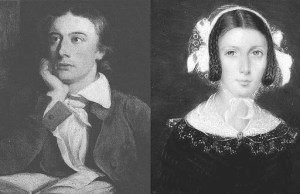The story of John Keats and Fanny Brawne is beautiful and tragic. Much of what we know about their relationship is because of the letters Keats wrote to Brawne throughout their short and ill-fated time together.
When their love was revealed in publication in 1878 (the year Dempsey & Carroll was founded!) Victorian readers were scandalized. Because Fanny’s letters to Keats had been destroyed there was only one side to the story and many people thought Keats had made a fool of Fanny, and that Fanny was flirtatious and shallow.
Theirs is one of the most famous love stories of all time. Grab some tissues and learn a little about the story of John Keats and Fanny Brawne…
In an 1818 letter to his brother George, John Keats (1795-1821) wrote about his neighbor Fanny Brawne (1800-1865), “…her daughter senior is I think beautiful and elegant, graceful, silly, fashionable and strange we have a little tiff now and then.”
They soon fell in love and this inspired many of Keats’s poems such as “The Eve of St. Agnes,” “Bright Star,” and “Ode to a Nightingale.”

Keats wrote many letters to Fanny throughout their relationship, professing his love to her and writing her poems.

Ah dearest love! sweet home of all my fears,
And hopes, and joys, and panting miseries
To night, if I may guess, thy beauty wears
A smiling of such delight,
As brilliant and as bright,
As when with ravished, aching, vassal eyes,
Lost in soft amaze,
I gaze, I gaze!
Keats fell ill and fevered in February of 1820 after a trip to London, and Fanny spent almost every day by his side that winter. When they could not be together he wrote her letters, and she in turn sent a note every night to be put under his pillow.

I can do nothing say nothing think nothing of you but what has its spring in the Love which has so long been my pleasure and torment. On the night I was taken ill when so violent a rush of blood came to my Lungs that I felt nearly suffocated – I assure you I felt it possible I might not survive and at that moment though[t] of nothing but you…

Upon my soul I have loved you to the extreme. I wish you could know the Tenderness with which I continually brood over your different aspects of countenance, action and dress. I see you come down in the morning: I see you meet me at the Window – I see every thing over again eternally that I ever have seen… .If I am destined to be happy with you here – how short is the longest Life – I wish to believe in immortality – I wish to live with you for ever… Let me be but certain that you are mine heart and soul, and I could die more happily than I could otherwise live.
(A letter from Kentish Town, where Keats moved to in the spring. Written June of 1820.)
In the autumn of that year, John’s friends suggested a trip to Italy to recuperate, and with her permission, he destroyed all of Fanny’s letters to him before his trip.
Despite moving there to improve his health, Keats grew progressively worse and missed Fanny terribly. In a letter from Wentworth Place, Charles Armitage Brown (a poet and friend of Keats) wrote, “Miss Brawne…looks more sad every day.”
Charles Brown wrote to Keats that Fanny was upset at not having received any letters, even though she had been writing to him. His reply…

The persuasion that I shall see her no more will kill me… My dear Brown, I should have had her when I was in health, and I should have remained well. I can bear to die – I cannot bear to leave her. Oh, God! God! God! Everything I have in my trunks that reminds me of her goes through me like a spear. The silk lining she put in my travelling cap scalds my head. My imagination is horribly vivid about her – I hear her. There is nothing in the world of sufficient interest to divert me from her for a moment… O that I could be buried near where she lives! I am afraid to write to her – to receive a letter from her – to see her handwriting would break my heart – even to hear of her any how, to see her name written would be more than I can bear… My dear Brown, for my sake, be her advocate for ever… I am afraid to write to her. I should like her to know that I do not forget her.
John Keats wrote this final letter to his sweetheart Fanny Brawne before dying.

Read the entire transcript of the letter from the New York Public Library here.
On February 23, 1821 Keats succumbed to tuberculosis and died. He was buried with several unopened letters from Fanny, it had pained him too much to read them.
The two never married, but Brawne was the great love of Keats’s life. She mourned his death as a widow. She cut her hair, dressed in black, wore a locket containing a piece of Keats’s hair, and wore the ring he had given her.

